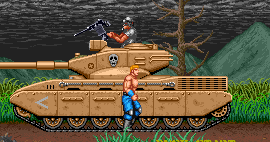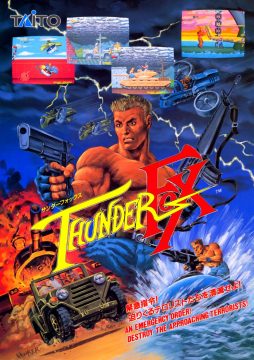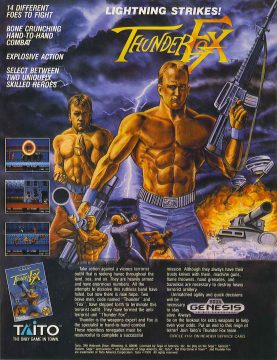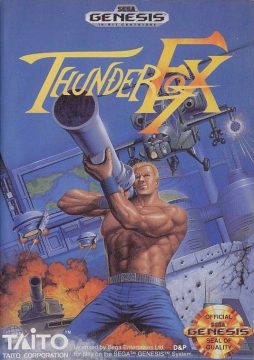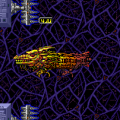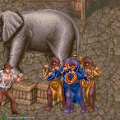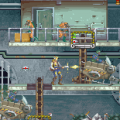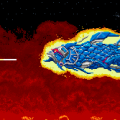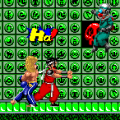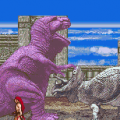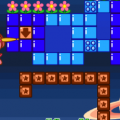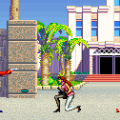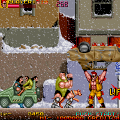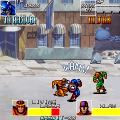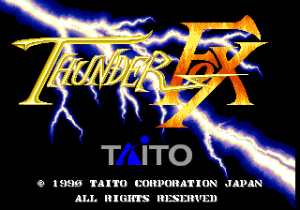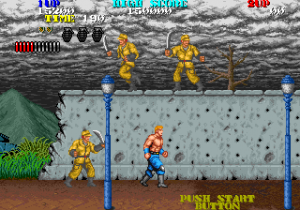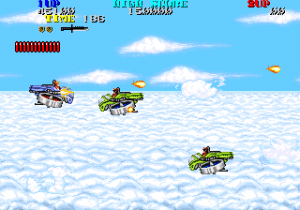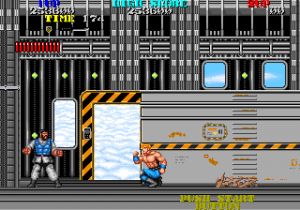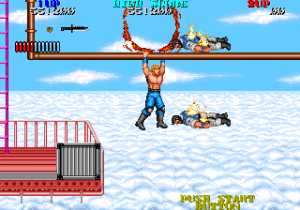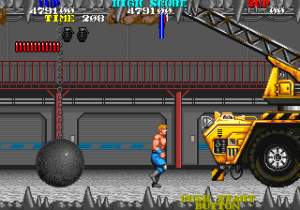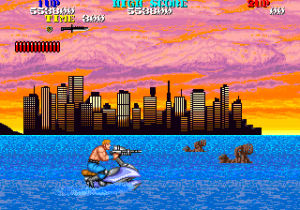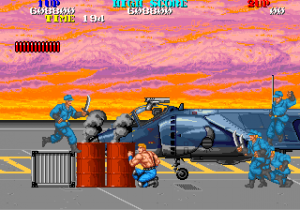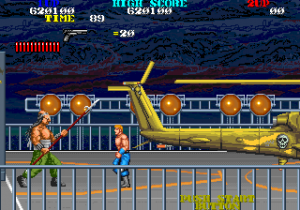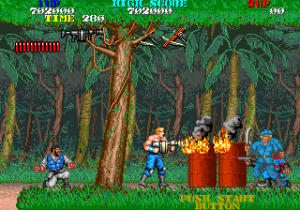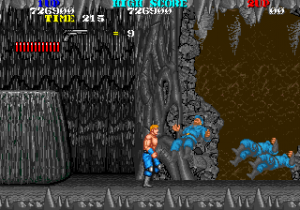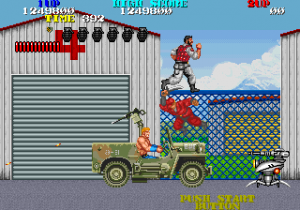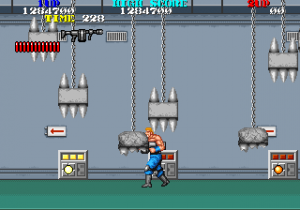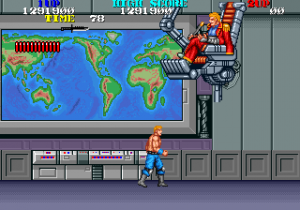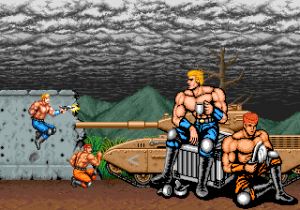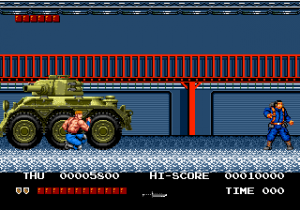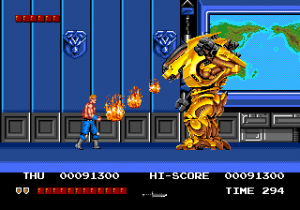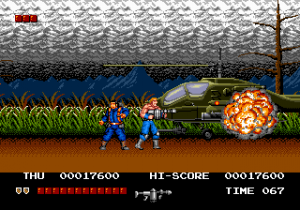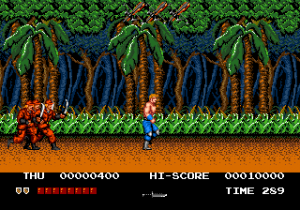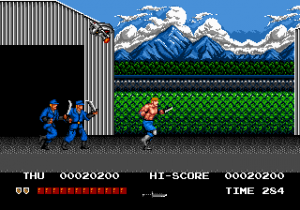In 1987, Taito released The Ninja Warriors, an action game where the player slowly strolls forward and fends off hordes of easily disposed mooks who attack from all angles. Despite the super cool widescreen effect created by sticking three monitors together, it was basically just an evolution of Irem’s Kung Fu Master from a few years before.
It’s not immediately apparent, but Taito’s ThunderFox is essentially a follow up to The Ninja Warriors, except it ditches the widescreen gimmick and changes the theme from “ninjas” to “80s action movie”. In that sense, the military theme is also very similar to Konami’s Green Beret / Rush’n Attack. The enemies are nebulous terrorists, who are threatening the world via undescribed means, and only the massively beefed-up soldiers Thunder and Fox have the muscles to beat them into submission.
The heroes walk onto the battlefield equipped with only a knife, so the action (as with all other similar games) is primarily focused on close combat. There are also numerous weapons dropped by enemies, however, including flame throwers, handguns, grenades, and bazookas, though their ammunition is extremely limited. Beyond the typical stabbings / shootings, the heroes can also jump kick, and execute super high jumping somersaults, which can be used to leap over barriers and attack airborne foes.
There are five levels in total, as the heroes trudge through a war-torn town and into the skies to destroy an aircraft carrier (conceptually this level is almost identical to a level in The Revenge of Shinobi, right down the doors that will suck you out if you get too close when they’re open). The assault continues on a submarine and an aircraft carrier, through a jungle, and then into the war room of the terrorist commander. A few of the bosses are vehicles likes tanks and cranes – obviously taking them down with your knife is incredibly difficult, so the game usually requires that you kill some human enemies and steal their grenades in order to take down these larger targets.
ThunderFox originated as an arcade game, and was later ported to the Genesis. While the Genesis version is playable, it’s still substantially cut back from its original form. The arcade version offers two-player simultaneous action, however, the Genesis port is single-player only. You can pick between the two characters, and while the manual insists they’re distinct individuals (one is better at melee combat, the other is a weapons expert), it’s hard to feel any differences. The game also runs slower, so it lacks the same oomph as the arcade version.
The Genesis version offers an easier difficulty level, which has an expanded life meter. It also includes a life meter for the bosses. Conversely, there are limited credits – you need to restart the stage instead of continuing where you left off – though they can be increased using a code.
The graphics are okay for an early Genesis game, but beyond the visual downgrade, it’s missing a lot of cool details from the arcade version. Take, for example, the first level, which is supposed to occur during a lightning storm. In the arcade version, lightning bolts strike the lamp posts, knocking them over, and in one case, creating a hole in the ground that you can fall into (which is ridiculous, but what 80s arcade game isn’t). Midway through the stage, rain begins pouring down heavily. There are unstable bricks when jumping onto a wall, which grant points when they collapse.
In the final stage, you have to deal with some obstacles like spiked ceilings and electrified floors. During the escape sequence from the air carrier in the second stage, you can see flaming bodies of dead enemies falling through the sky. None of these are in the Genesis version.
In fact, a whole lot more has been cut out. The jeeps that you can use to plow through enemy brigades? Gone. There are two vehicle sections where you take to the skies in a gyro copter and speed on over the ocean on a jet ski. These are completely missing. It’s also pretty lazy that the pre-level text wasn’t changed to reflect these cuts – the introduction to level three still commands you to chase a submarine…except it begins with you standing right on top of it, since the chase scene was cut.
Some of the boss battles have changed, too. In the arcade version, the boss for the first level is a tank; this was changed to a helicopter in the Genesis port. There’s still a boss battle against a tank in the Genesis version, but it was moved to the end of the fourth level, where it replaces the fight against a gigantic crane, which attacked by dropping a wrecking ball on you. For all of the stuff that the game removed, the only thing they added is an extra boss fight against a gigantic yellow mecha before facing off against the final baddie.
ThunderFox isn’t a complicated game by any stretch of the imagination, but a lot of the smaller details helped to keep the game fresh in its original form. With many of these elements removed in the Genesis port, the overall experience suffers substantially. At least they kept the same ending as in the arcade, where Thunder and Fox reminiscence about their battles over a cup of coffee.
